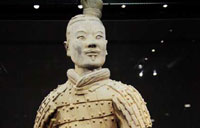Taking the rare Qin terracotta warriors and horses around the world for exhibitions entails much difficulty and detailed preparations for those responsible for their care.
An exhibition of terracotta warriors from Xi'an, the capital of Northwest China's Shaanxi province, at the Children's Museum of Indianapolis in Indiana, the United States, from May 10 to Nov 2 is proving to be a hot attraction. The preparations for the exhibition also make an interesting story.
 |
| Dressing of the Qin Terracotta Warriors |
The display, "China's Terracotta Warriors — the Emperor's Painted Army", showcases 265 rare cultural relics, including life-sized warriors unearthed from pits next to the Mausoleum of Emperor Qin Shihuang, the first emperor of the Qin Dynasty (221 – 206 BC).
Among the exhibits, 18 are listed as first-class relics under national protection.
Pang Yani, director of the Shaanxi Cultural Heritage Promotion Center, which organizes overseas heritage exhibitions under the Shaanxi provincial administration of cultural heritage, said preparations for overseas exhibitions begin two to three years before the show is scheduled and the plan and relics to be exhibited must be approved by the State Administration of Cultural Heritage.
"Overseas exhibitions like that in the Children's Museum of Indianapolis are held several times in different countries by Shaanxi province," Pang said.
In order to prepare the exhibition and carefully protect the heritage items that are being sent overseas, Chinese and foreign experts make careful checks.
On April 12, Pang said, program managers from her center and experts from the Children's Museum, as well as staff from the Shaanxi Huaxie International Treasures Freight Services Co, which was responsible for transporting the heritage items, went together into the treasury to check the relics chosen for the exhibition.
"The rare relics including the Qin terracotta warriors were collected from museums throughout Shaanxi province and packed in more than 10 large wood boxes," Pang said.
Staff from the three institutions carefully checked and transferred each piece, including a set of a stone armor, a class-one heritage with national protection unearthed from near the Mausoleum of Emperor Qin Shihuang in Lintong district, an eastern suburb of Xi'an.
In order to check each piece of the armor, the Chinese and US experts divided its 617 stone pieces into nine areas — each shoulder, the chest, back, upper body, both ribcages, the breast and lower back — and then inspected every part.
"We checked if any piece of the armor had stains or was incomplete and recorded it," said Zhang Zheng, a program manager with the center.
Zhang said it took more than five hours to complete the inspection of the armor and it was hard work.
They similarly inspected every item and recorded everything in minute detail. The records were then translated into both Chinese and English versions and signed by those involved.
"Although that suit of armor had been exhibited many times overseas, we could not use the previous records for the next exhibition but have to check the relics again and again before every exhibition, as we must not make any mistakes with these very much precious relics," Zhang said.
In addition to the written records, more than 200 photographs were taken of the relics.
The experts would repeat their careful inspections after the exhibition is over, Zhang said.
After the relics were all checked, they were packed with care by the transport company, said Zhu Yonghong, deputy general manager of Shaanxi Huaxie International Treasures Freight Services.
"Each relic gets customized custom packaging according to its texture with acid-free paper that protects the heritage item from surface wear," Zhu said.
The treasures were then put into wooden or brocade boxes with padded interiors to protect the items from shock and moisture, Zhu said.
"The packaging boxes were made of special fumigation-free wooden board which could not be compromised by borer," the deputy general manager said.
The vehicles for transporting the exhibits were also specially equipped to maintain a constant temperature and absorb shocks, and their speed was limited to between 60 and 80 km per hour. There were also strict security measures during the transportation from the treasury to the exhibition places.
Zhu said the heritage items to be displayed in foreign countries must be declared to customs in advance and then his company sends the exhibits by air to their destination countries via Shanghai.
